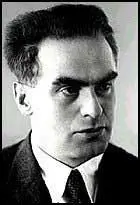Rudolf Slansky

Rudolf Slansky was born in Moravia in Czechoslovakia in 1901. He joined the Czechoslovakian Communist Party when it was formed in 1929 and soon became a close associate of its leader, Klement Gottwald.
The German Army marched into the Sudetenland on 1st October, 1938. Slansky fled to the Soviet Union where he remained for most of the Second World War. In 1944 he returned to Czechoslovakia where he assisted the Slovak uprising.
In March 1945 Eduard Benes flew to Moscow and after meeting Joseph Stalin agreed that in his post-war coalition he would accept several Soviet-trained Czechs. Benes and Jan Masaryk accompanied the Russian-sponsored Czechoslovak Corps that liberated the country from Nazi Germany in May 1945. Slansky became Secretary-General of the Czechoslovakian Communist Party. In the 1946 general election the Communist Party won the largest number of parliamentary seats with 38 per cent of the votes. Klement Gottwald set up a National Front government but caused great controversy when under the orders of Joseph Stalin, he rejected Marshall Aid.
In June 1948, when it became clear that Gottwald intended to introduce a Russian-style political system, Eduard Benes resigned as president. Later that year Jan Masaryk was found dead. He had either been murdered or had committed suicide in protest at the imposition of a Stalinist political system.
Slansky refused to follow the orders of Joseph Stalin and in September, 1951, he was arrested and charged with being a follower of Josip Tito of Yugoslavia. Sam Russell, a journalist with the Daily Worker, covered the case. At the time he considered the evidence as genuine but according to Roger Bagley it was an experience which "left a deep scar."
Rudolf Slansky was executed on 2nd December, 1952.
